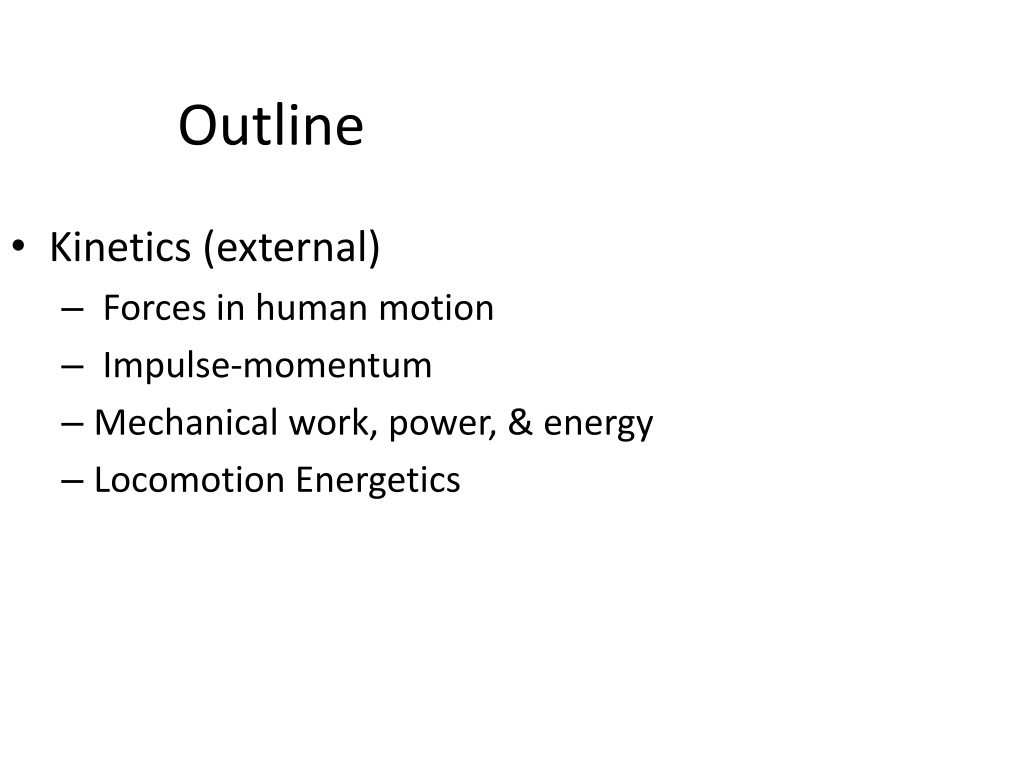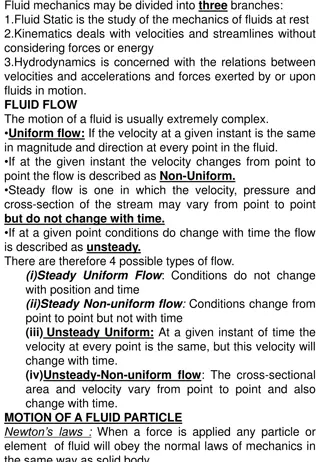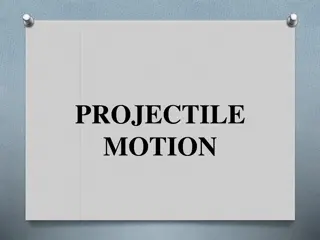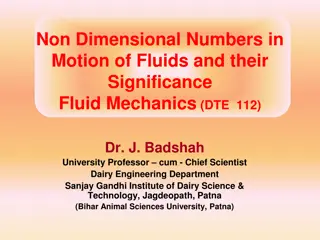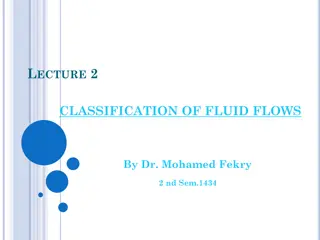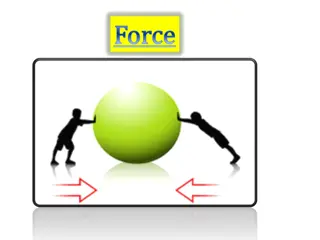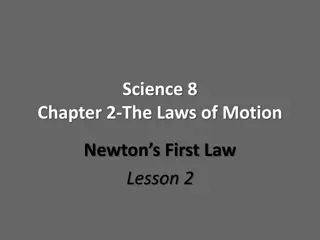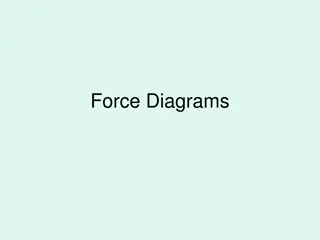Human Motion Kinetics: Forces and Fluid Resistance
Exploring the dynamics of forces in human motion, this outline covers topics such as impulse-momentum, mechanical work, power, energy, and locomotion energetics. It delves into the influence of gravity, ground reaction, friction, fluid resistance, and more on human movement, with detailed readings on Newton's Laws, friction, fluid resistance, impulse-momentum, and mechanical energy. Factors affecting fluid resistance and components of drag force are also discussed, emphasizing the impact of density and viscosity.
Download Presentation

Please find below an Image/Link to download the presentation.
The content on the website is provided AS IS for your information and personal use only. It may not be sold, licensed, or shared on other websites without obtaining consent from the author.If you encounter any issues during the download, it is possible that the publisher has removed the file from their server.
You are allowed to download the files provided on this website for personal or commercial use, subject to the condition that they are used lawfully. All files are the property of their respective owners.
The content on the website is provided AS IS for your information and personal use only. It may not be sold, licensed, or shared on other websites without obtaining consent from the author.
E N D
Presentation Transcript
Outline Kinetics (external) Forces in human motion Impulse-momentum Mechanical work, power, & energy Locomotion Energetics
Outline Kinetics Forces in human motion Gravity Ground reaction Inertial (F = ma) Centripetal Friction Fluid Resistance Multi force Free body diagrams Dynamic and Static Analysis with Newton s Laws
Reading Newton s Laws Ch 2: pages 41-44; 46-61 Friction Ch 2: pages 61-62 Static/Dynamic Analyses & FBDs Ch 3: pages 107-124 Fluid Resistance Ch 2: pages 63-68 Linear Impulse/Momentum Ch 2: pages 68-72 Mechanical Energy/Work/Power Ch 2: pages 81-90 Applications (Locomotion, Jumping) Ch 4: pages 145-159
Human movements where fluid resistance is important?
Factors affecting fluid resistance Density mass per unit volume resistance to motion through a fluid increases with density Viscosity a measure of the fluid s resistance to flow
Figure 2.20 Components of Fluid Resistance Drag Force: Opposes motion Lift Force: perpendicular to motion
Components of drag force Surface drag: friction of fluid rubbing on surface Pressure drag: front-back pressure differential Wave drag: waves at interface of two fluids.
Streamlines Drag force is effected by: 1) different velocities of the streamlines 2) the extent to which the relative motion of the streamlines is disturbed
Laminar flow Uniform layers of different speed Slowest layer closest to the surface of the object
Laminar flow: Surface drag dominates Velocity of air Air direction relative to ball
Surface drag also called skin friction Depends on velocity of fluid relative to surface roughness of surface surface area of object properties of fluid
Reducing surface drag Speed skater: wearing a smooth spandex suit 10% less surface drag than wool clothes Cyclist: wearing Lycra long sleeved shirt, tights, and shoe covers Swimmer: Shaving body hair
Surface drag Surface drag: Friction within boundary layer human movement in air: surface drag (3-5%) small compared to pressure drag (95-97%)
Pressure drag: dominant form of drag in human movement Higher Pressure Lower Pressure Turbulent flow: Non-uniform flow of fluid around an object Pressure differential causes a pressure drag force .
Streamlining reduces turbulence and pressure drag Flow remains laminar for longer -- less turbulence less pressure drag Enoka, Figure 2.3A
Pressure drag vs. surface drag Pressure drag: dominates for large objects moving in low density & viscosity fluids e.g., human running, cycling in air Surface drag: dominates when small objects moving in high viscosity fluids, e.g. sperm swimming
Pressure drag force Fd = (0.5 CD)Av2 = fluid density air: 1.2 kg/m3 water: 1000 kg/m3 CD = coefficient of drag A = projected area (m2, frontal area as object moves through the fluid) v = velocity of the fluid relative to the object (m/s)
Coefficient of drag (CD): combines shape & aspect ratio index Unitless Magnitude depends on shape of object orientation of object relative to fluid flow Independent of size Streamlining reduces CD
Coefficient of drag examples Mackerel: 0.0053 Rainbow trout: 0.15 Pigeon or vulture: 0.4 Sphere: 0.47 Human swimmer: 0.66 Cyclist and bike: 0.9 Runner: 0.9 Flat plate: 1.0
Velocity (v) of fluid relative to the object Example: vcyclist = 7 m/s Still air: vair = 0 Headwind: vair = 7 m/s Tailwind: vair = 7 m/s v = vobject - vair vobject
Velocity (v) of fluid relative to the object Example: vcyclist = 7 m/s Still air: vair = 0 v = 7 m/s Headwind: vair = -7 m/s v = 14 m/s Tailwind: vair = 7 m/s v = 0 m/s v = vobject - vair vair vobject
Components of drag force Surface drag: friction of fluid rubbing on surface Pressure drag: front-back pressure differential Wave drag: waves at interface of two fluids.
Figure 2.20 Components of Fluid Resistance Drag Force: Opposes motion Lift Force: perpendicular to motion
Lift Force Asymmetric objects Spinning object Bernoulli s Principle: Pressure is inversely proportional to the velocity of the fluid
High Velocity Low Pressure Low Velocity High Pressure
Drag acts in horizontal (x) direction, opposite to the direction of locomotion Drag
Drag in locomotion (Fd = 0.5 CDAv2) Walking or running in air (CD = 0.9, = 1.2 kg/m3) 0.5 CD = 0.55 kg/m3 Fd = 0.55Av2 Frontal area (A) = 0.4 m2 Fd (Newtons) = 0.22 * v2
Role of Fd in locomotion Person in still air Walk (1.25 m/s): Fd ~ 0.001 Fg,x Run (4 m/s): Fd ~ 0.01 Fg,x Run (8 m/s): Fd ~ 0.025 Fg,x Person in headwind of 17 m/s (~ 35 mph) Run (8 m/s): Fd ~ 0.25 Fg,x
Drag in cycling (Fd = 0.5 CDAv2) For cyclist in air (CD = 0.9, = 1.2 kg/m3) 0.5 CD = 0.55 kg/m3 Fd = 0.55Av2 Frontal area (A) of cyclist & bike Touring position (upright): 0.5 m2 Racing position: 0.3 m2 Recumbent position: 0.2 m2
Touring Cycling Racer Recumbent
Swimming Water density >> air density greater pressure drag Fd = 0.5 CDAv2 = 1000 kg/m3 CD = 0.66 A = 0.073 m2 Fd (swimming) = 24* v2 Comparison: Fd (walk, run) = 0.22 * v2
Drag: walking vs. swimming Drag force comparison at a given speed Fd (swimming) ~ 100 x > Fd (walk, run in air) Reasons Water density >> air density frontal area less Cd less for swimming position
Total force: walking vs. swimming Swimming Drag: largest force 2 m/s ---> Fd ~ 0.14 * body weight Walking Ground reaction force: largest force 2 m/s ---> Fg ~ 1.5 * body weight
Problem: Friction force on slope Fn mg Find maximum friction force in terms of mg, , & s.
Friction force on slope Fn mg Fs,max = Fn s Fn = mg cos Fs,max = s mg cos Fparallel (force pulling downhill parallel to slope) = mg sin
Friction vs. Gravity force parallel m=70kg s = 0.5 theta = 30 degrees Solve for static friction force and the component of gravitational force pulling parallel to the slope.
Recitation a skier starts at the top of a 30 degree incline,init. vel. = 0 considering gravity, air resist. & friction, draw a FBD.
Recitation a skier starts at the top of a 30 degree incline,init. vel. = 0 considering gravity, air resist. & friction, draw a FBD If = 0.050 and mass is 70.0kg, what is max. frictional force? add that number to FBD
Recitation If frontal area is 0.600 m^2, air density is 1.200 kg/m^3, Cd is 0.9, what is air resist force when velocity = 10 m/sec add this # value to your FBD
Neglect or Do Not Neglect? if we include air resistance, kinematic problems get more difficult. In the bike lab we will take aero force into account and use an iterative computer approach.
Recitation What is the fastest velocity that can be reached by the skier. i.e. what is terminal velocity?
